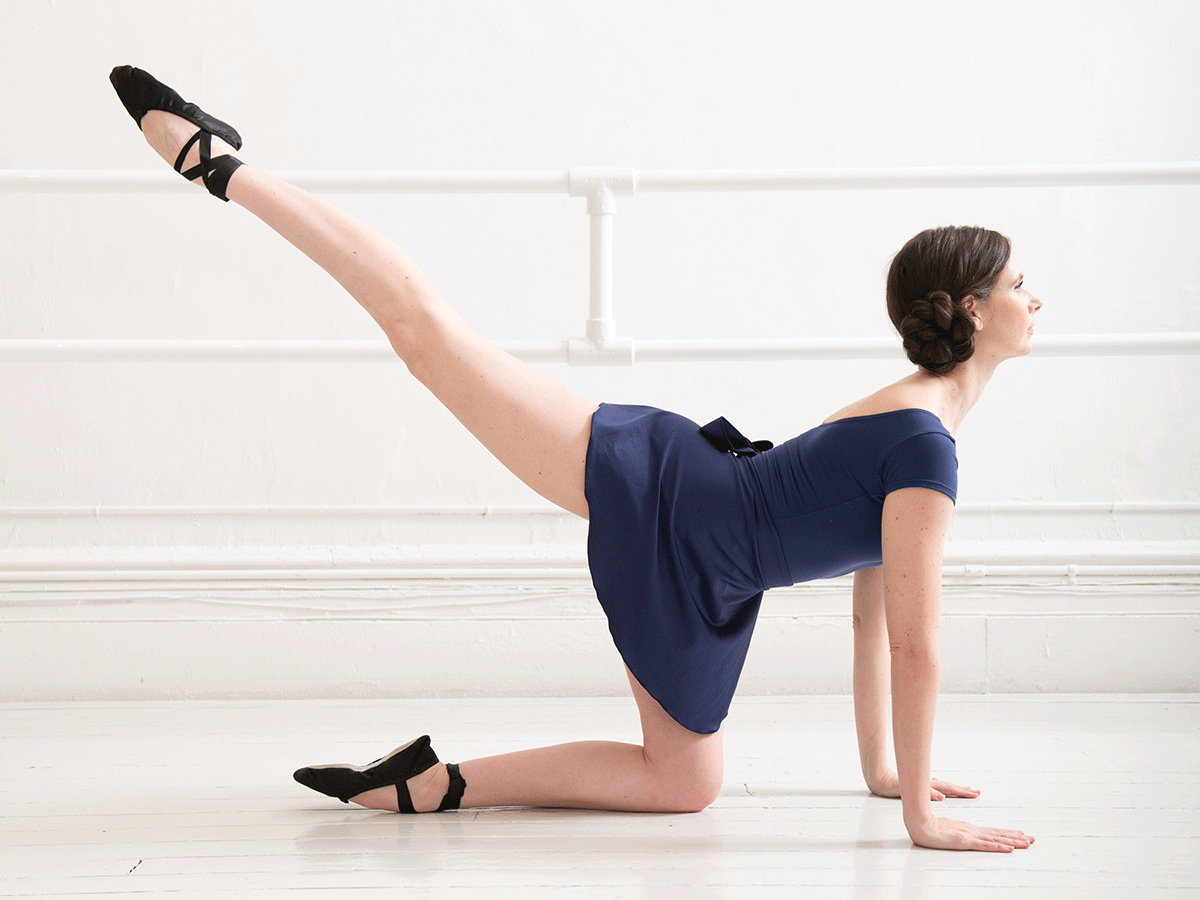
Why ballet is good for flexibility and posture
There you are in your makeshift workout zone (née your go-to fitness studio), following your e-trainer’s moves, keeping perfect posture as you effortlessly touch your toes, move into downward dog and then down dog splits. No, not you? Same. For some, flexibility and good posture doesn’t come quite as naturally as it does for others and instead requires extra effort. For that, you may want to try certain stretches—ones that target tight muscles, work areas that are easily neglected, and elongate the body—like the ones that are popular with the ballerina set.
“With ballet, everything is about the extension of the body through space,” says Mary Helen Bowers, founder of Ballet Beautiful and previously a ballerina with the New York City Ballet. She created the model-loved fitness program (which is offered in-studio in New York City’s Soho neighbourhood as well as online) based on the fitness routine she put together for herself when she was dancing. Inspired by real ballet moves, Ballet Beautiful helps build strong, long muscles, improve posture and increase flexibility, she says.
“Everybody can increase their flexibility,” says Bowers, but the only way you’ll be more flexible is if you make stretching a priority. “One of the most important things for flexibility is consistency,” she says. You need a series of effective stretches that can easily be squeezed into your daily schedule—after your morning shower, during an afternoon break, or while your dinner cooks in the oven, says Bowers. So, pre-quarantine, we met up with Yukiko Kashiki, a master trainer at Ballet Beautiful in New York, to learn the best stretches for improving flexibility. Here, an easy routine that takes just 10 minutes a day.
(Related: 4 Expert Tips You Need to Know to Stretch Properly)
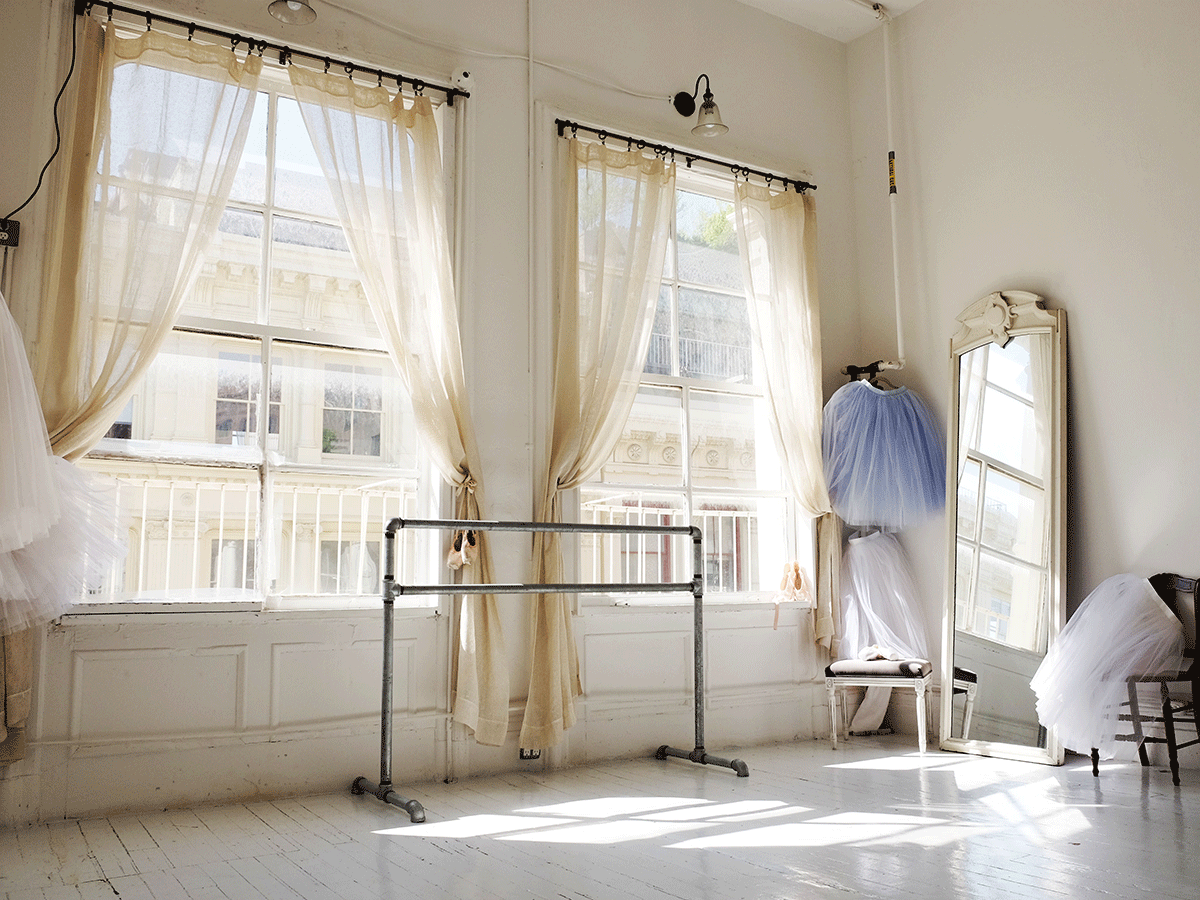
What to know before you begin
The best time to stretch
“It’s always better when you’re warm,” says Bowers, “but I think the most important thing is to just do it when you can—when you have the time.” Worry less about performing the stretches at a certain time, and worry more about being consistent by making time to stretch every single day.
Hold each stretch for four sets of eight
Count slowly when holding each pose. “Holding” doesn’t mean freeze, says Kashiki. Focus on maintaining the correct placement and feeling the stretch.
Focus on your breathing
When counting, concentrate on inhaling and exhaling. It helps to reduce tension while allowing your body to open up and sink deeper into each stretch, says Kashiki.
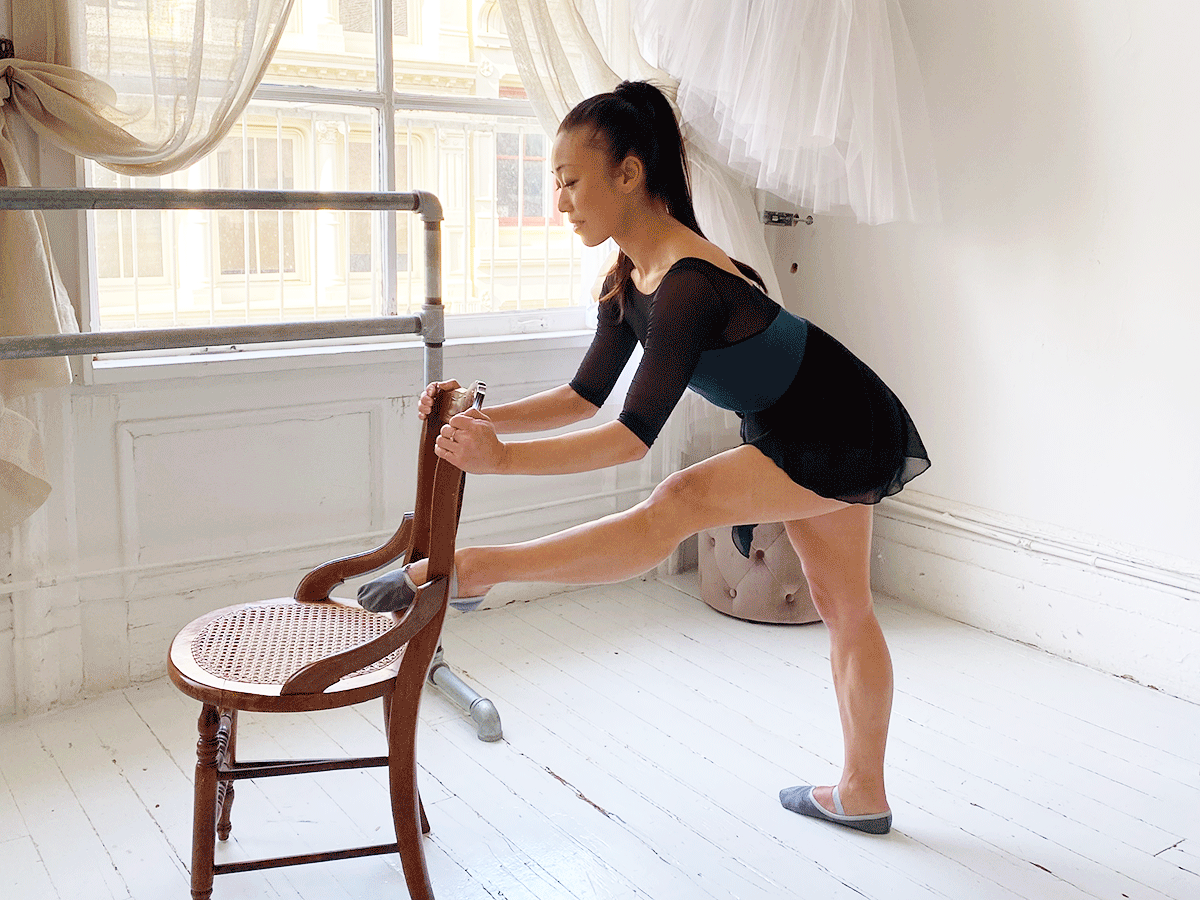
Move 1: Standing Hamstring & Hip Flexors Stretch
Grab a chair and stand behind it. Legs can be in parallel or natural turn-out, whichever is comfortable. Place one foot onto the chair, hold onto the back, and stretch both legs. Focus on creating a long line from the top of your head to your tail bone. Try not to let your lower back curve. Hinge towards the leg on the chair. If this isn’t possible, stay upright to maintain the straight line. Hold for four counts of eight. You should feel this stretch in your hamstrings, hip flexors, lower back, and possibly your calves. Bend the knee of the leg on the chair into a lunge, leaning in towards the chair. Hold for another four sets of eight. Repeat with the other leg.
Total time: 2 minutes, 8 seconds
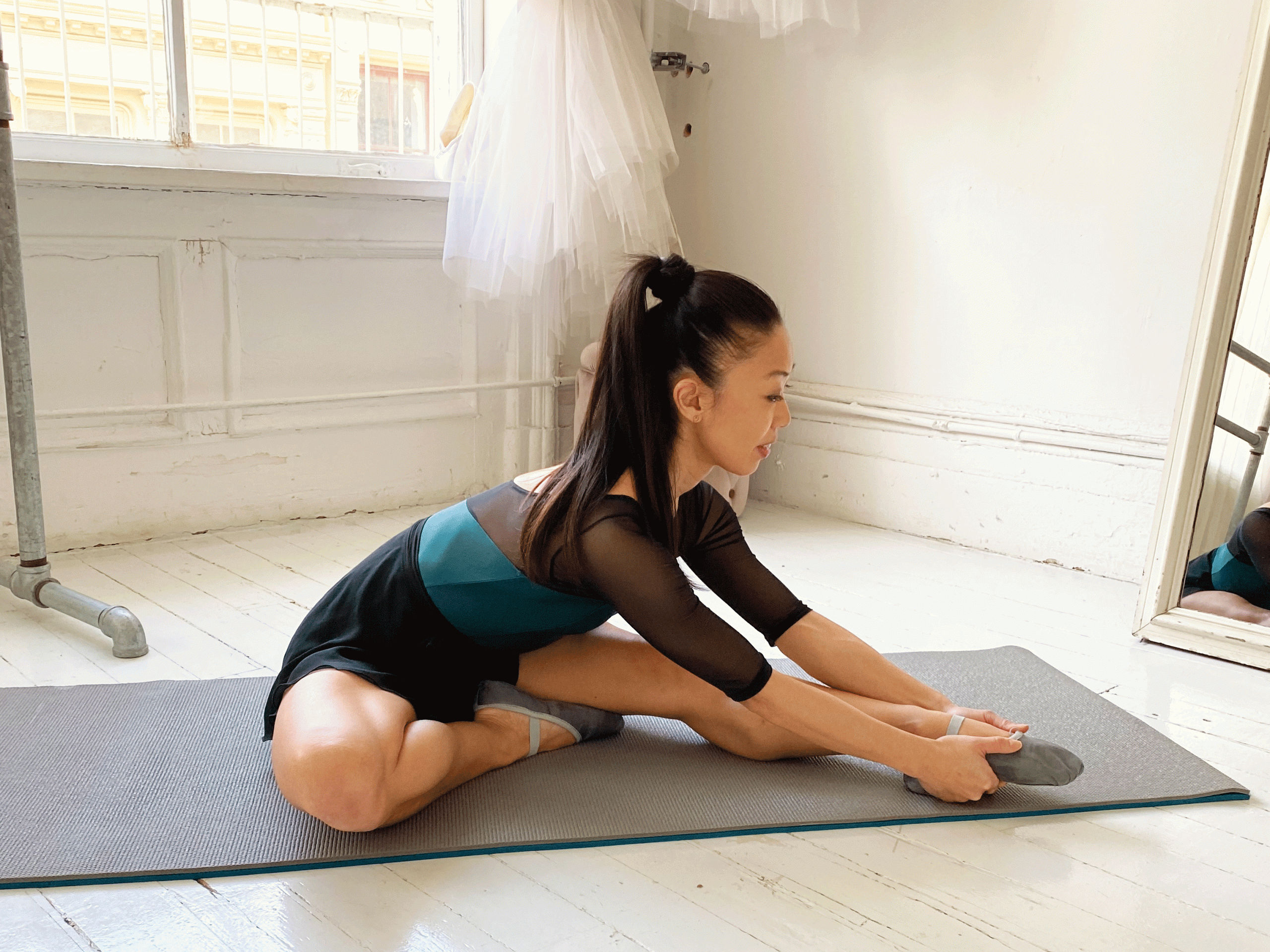
Move 2: Hamstring Stretch
Start by sitting on the floor with your knees open and the bottoms of your feet together. Extend your one leg in front of you, Reach towards your foot, and hold it. Your back should be straight, not curved. The bottom of your ribcage should be touching your thigh as you reach towards your toes. If that’s not possible, bend your extended leg to maintain the proper posture. The knee of the extended leg should be facing the ceiling or slightly rotated outwards, depending on your hip range. You should feel this stretch in your hamstrings as well as the lower back. Hold for four counts of eight, and repeat with the other leg.
Total time: 1 minute, 4 seconds
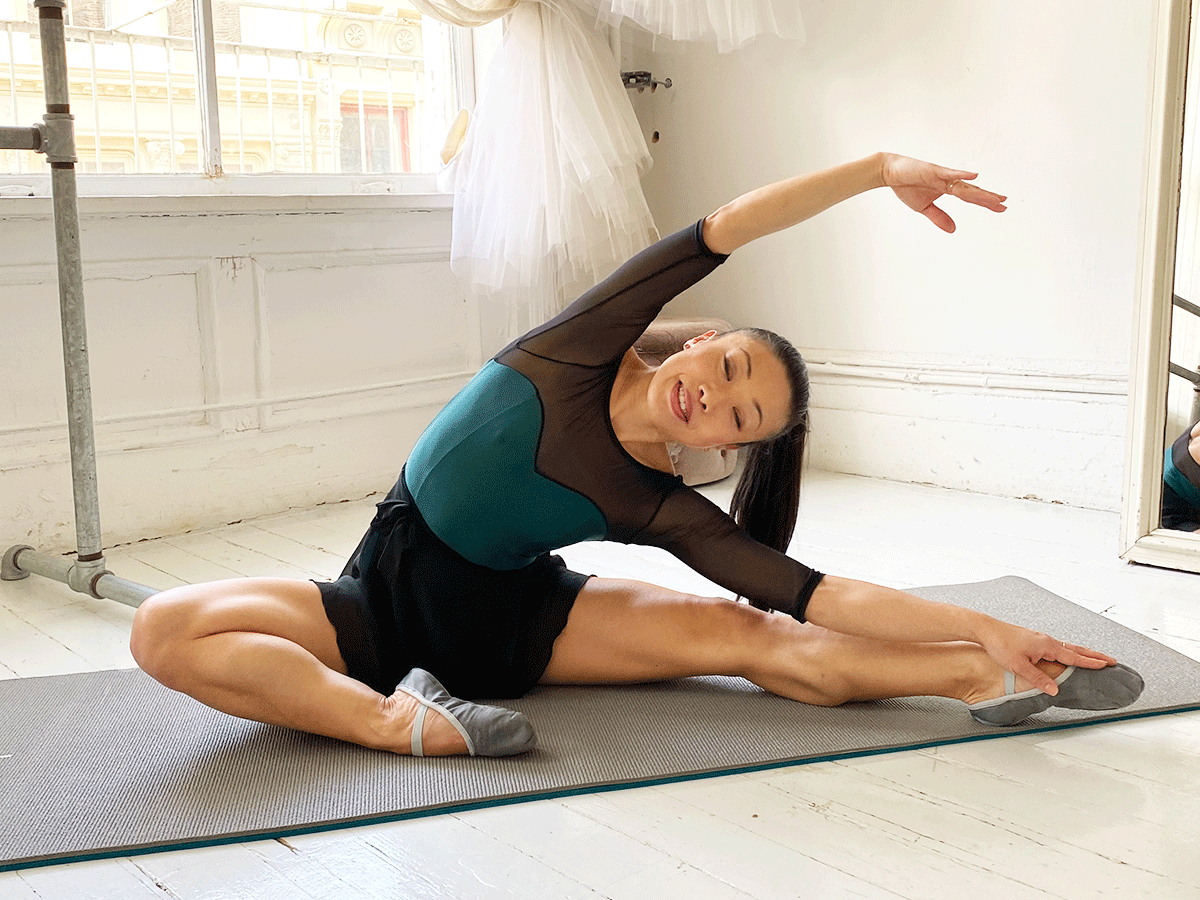
Move 3: Inner thigh stretch
Again, start by sitting with the bottoms of your feet together. Extend one leg to the side and reach the opposite arm up and over towards the extended leg. Relax and drop your shoulders, and reach your arms further, framing your head between them. Keep hips square. (Square means straight, not tilted, in relation to your shoulders.) If you have difficulty keeping this position, bend the knee of the extended leg. You should feel this stretch in the inner thigh of the extended leg, external and internal obliques, and in the arm that’s stretched above your head. Hold for four counts of eight, and repeat with the other leg.
Total time: 1 minute, 4 seconds
(Related: The Types of Stretching Fitness Experts Recommend—and One They Avoid)
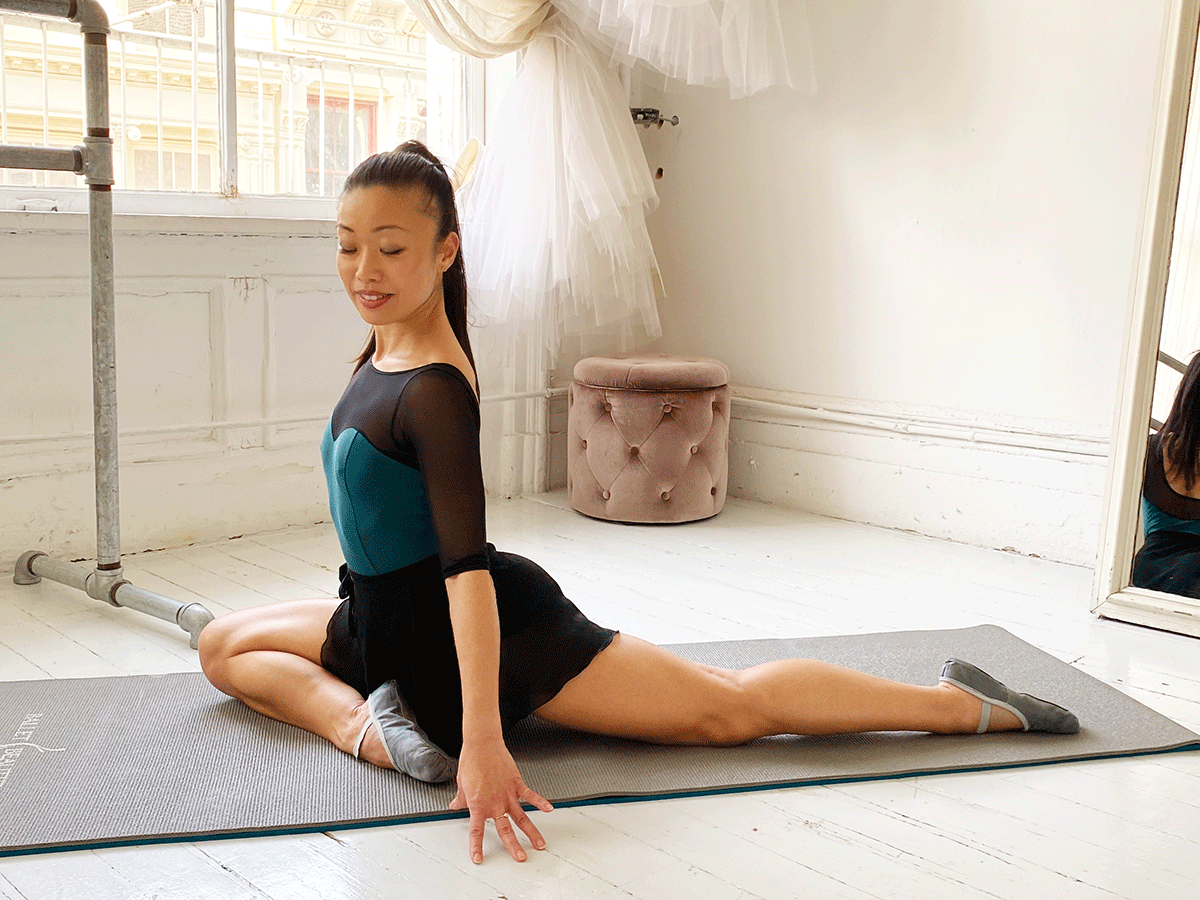
Move 4: The (loose) pigeon
The pigeon move works out tight hip flexors and hip rotators, while loosening hips and helping to prevent injuries. The easiest way to get into this position is from the stretch above, the inner thigh stretch. With one leg bent and the other leg extended, pivot towards the bent leg and extend the other leg behind you. Your shoulders should be directly on top of your hips, squared and aligned. Lean forwards and move your arms towards the bent knee. Your back leg can be slightly bent, if necessary. You should feel the stretch in your hip flexors as well as your outer and inner thighs. The more you do this stretch, the more you’ll be able to open your hip, which is the goal. Hold this position, stretching your torso and reaching over to the bent knee, for four counts of eight, then repeat with the other leg.
Total time: 1 minute, 4 seconds
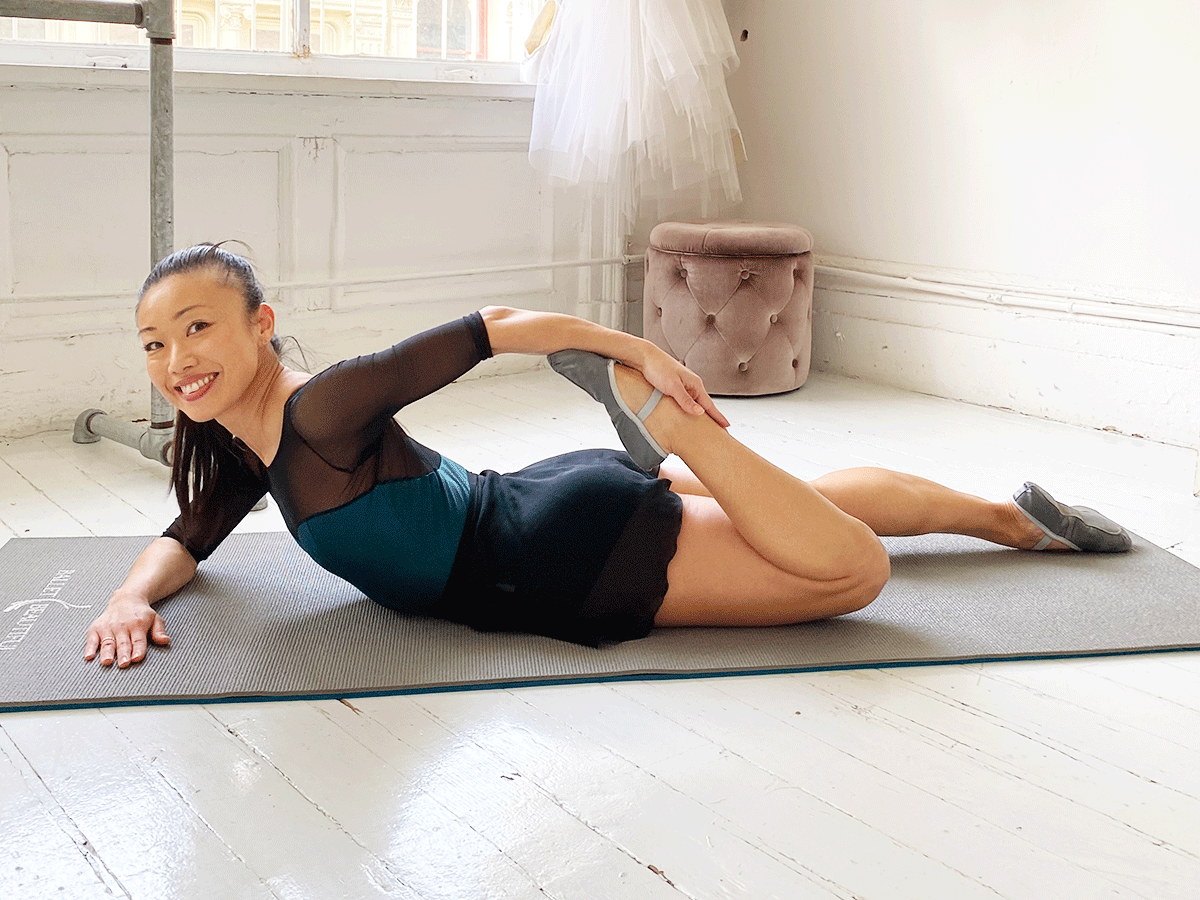
Move 5: Quad Stretch
You may be used to doing this move while standing up, before or after a workout, but it’s more effective to perform lying on your stomach. When you’re standing, you have the tendency to sit on the hip, and not pull the leg back enough. On the ground, your alignment is automatically correct, which ensures you get the right stretch.
Rest on your elbows in front of you, with your legs straight behind you. Bend one leg and hold it with the hand on the same side, and pull your foot towards your bottom. You should feel the stretch in your outer thighs and glutes. You may feel tension in your lower back being released. Hold for four sets of eight, and switch legs.
Total time: 1 minute, 4 seconds
(Related: 4 Quad Stretches Everyone Should Know)
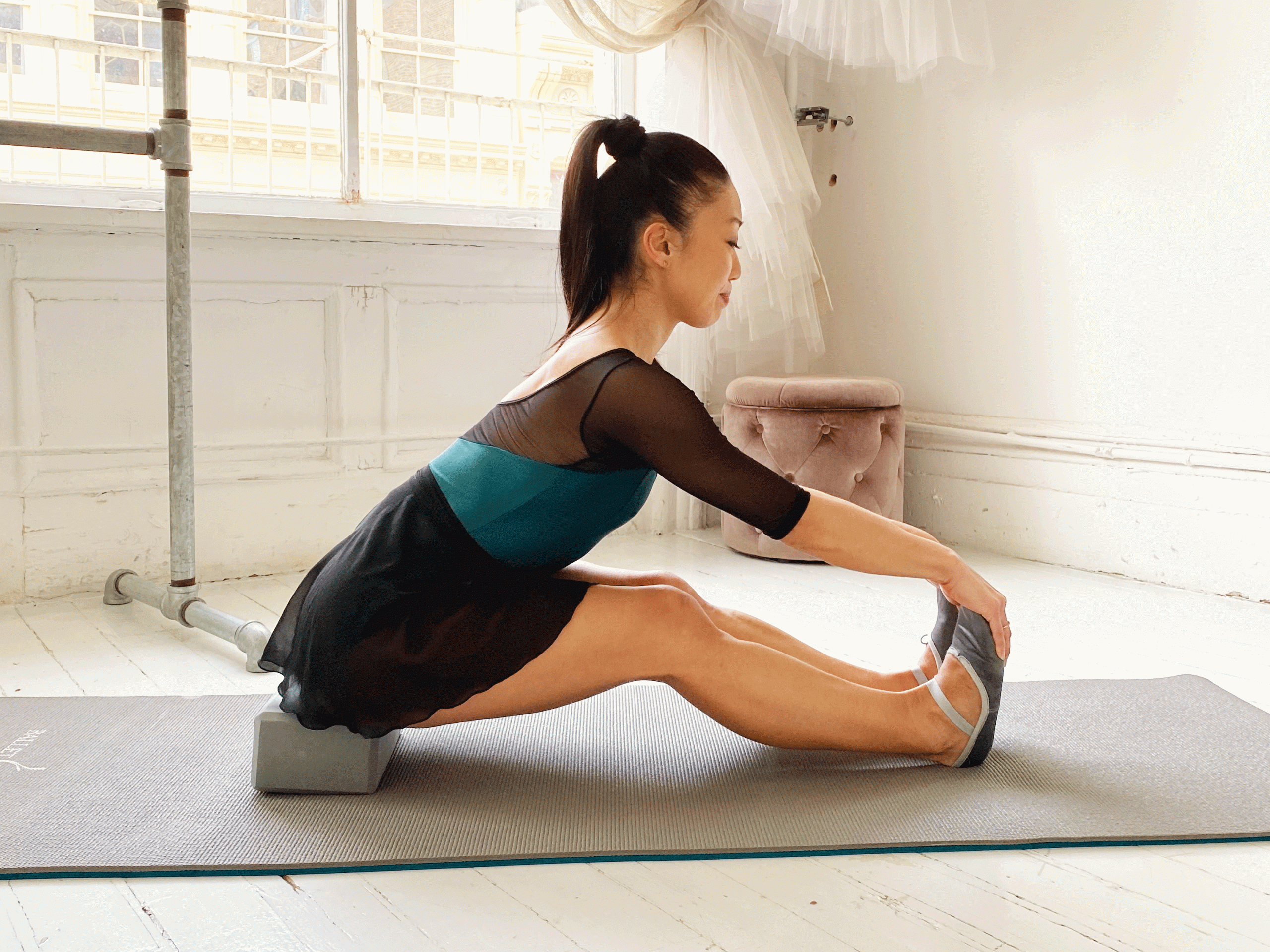
Move 6: Seated Hamstring Stretch
Grab a block or some books to sit on—this will help prevent slouching when you lean forward and touch your toes. Stretch your legs, and bring the bottom of your ribcage close to your thighs while keeping a straight back. Bend your knees if necessary, and grab onto your toes, ankles, or shins. Lift your chest forward, without curling your back and keep shoulders down. You should feel the stretch in your lower back, which can help improve overall mobility and help reduce back pain. Take deep breaths, and hold for four sets of eight. For a deeper stretch, flex your feet.
Total time: 32 seconds
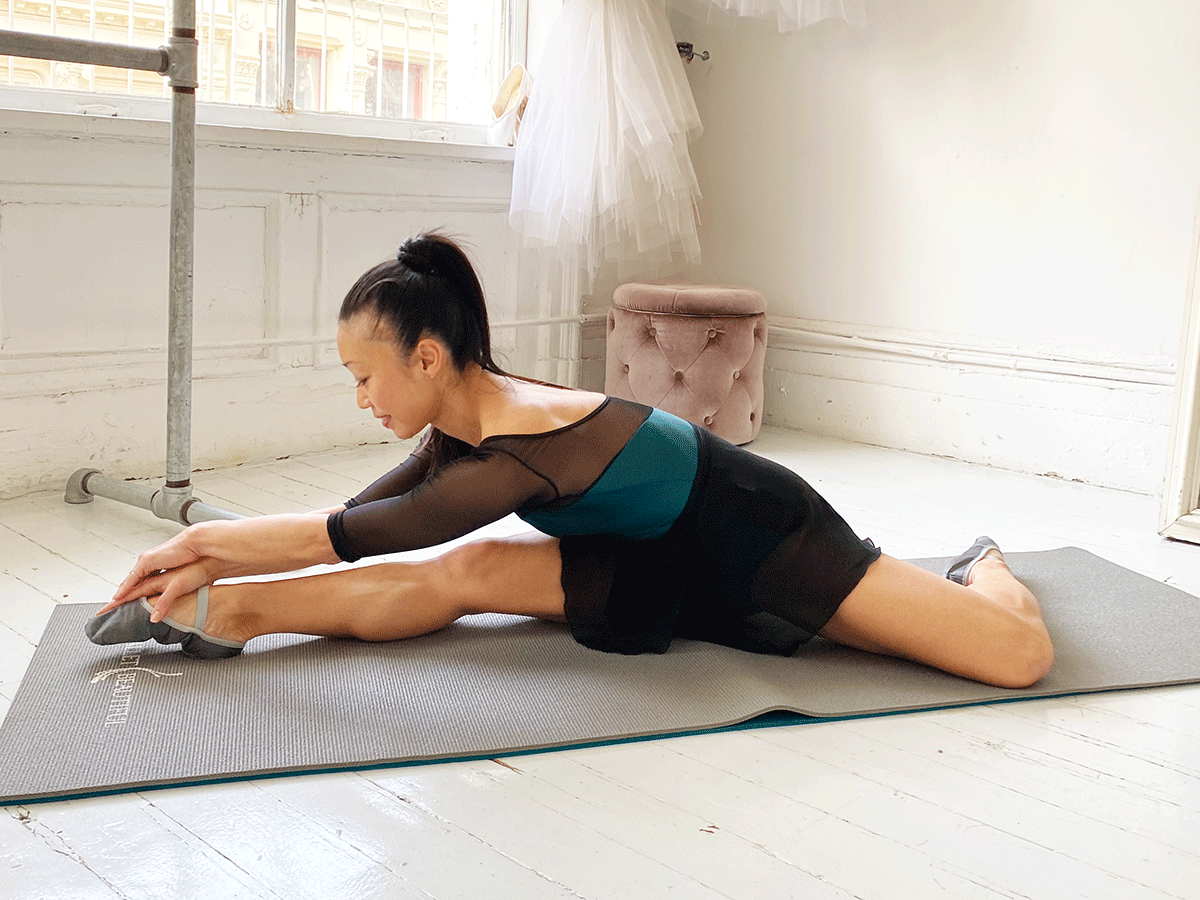
Move 7: The splits
Bend one knee behind you, from a 9 o’clock position, and extend your other leg in front of you, keeping hips and shoulders square. Stretch your back leg as far as it’ll go, and aim to extend it a little farther week by week. Stay upright, or if you wish, reach towards your toes. You should feel the stretch in your hamstrings, hip flexors, lower back, and inner thigh. Hold for four counts of eight, and repeat with the other leg.
Total time: 1 minute, 4 seconds
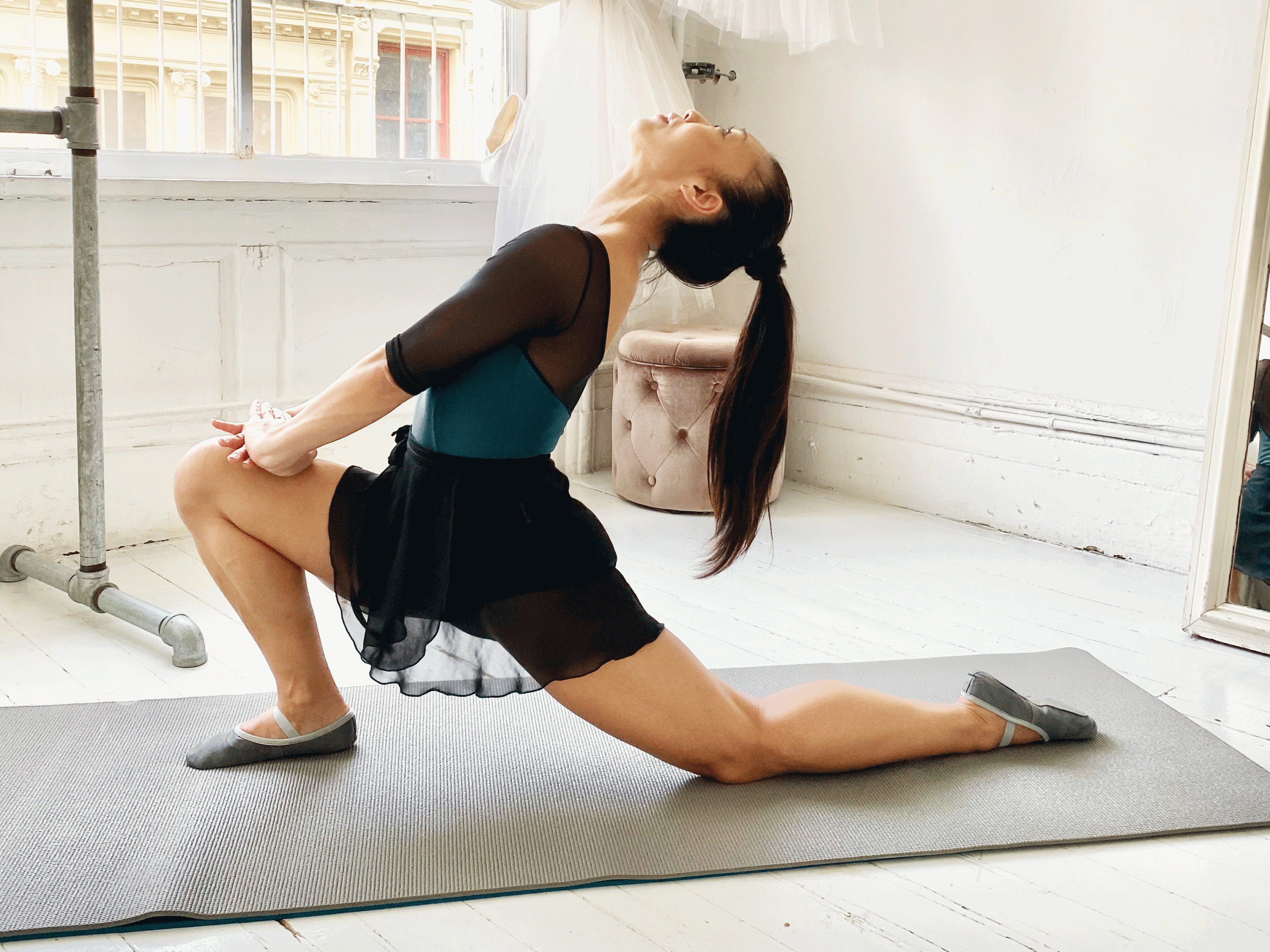
Move 8: Lunge Stretch
Bend one knee, making sure the knee is in line with your toes, and stretch out the other leg behind you. Keep your spine tall, and use your hands to push away from the bent knee. Lift from your waist, mid-section and open your chest. Keep in mind this is not a back bend. Keep lifting your chest towards the ceiling without putting pressure on the back of your neck. You should feel the stretch in your hamstrings, hip flexors, back, and chest. Repeat with the other leg.
Total time: 1 minute, 4 seconds
(Related: 4 Calf Stretches Everyone Needs)
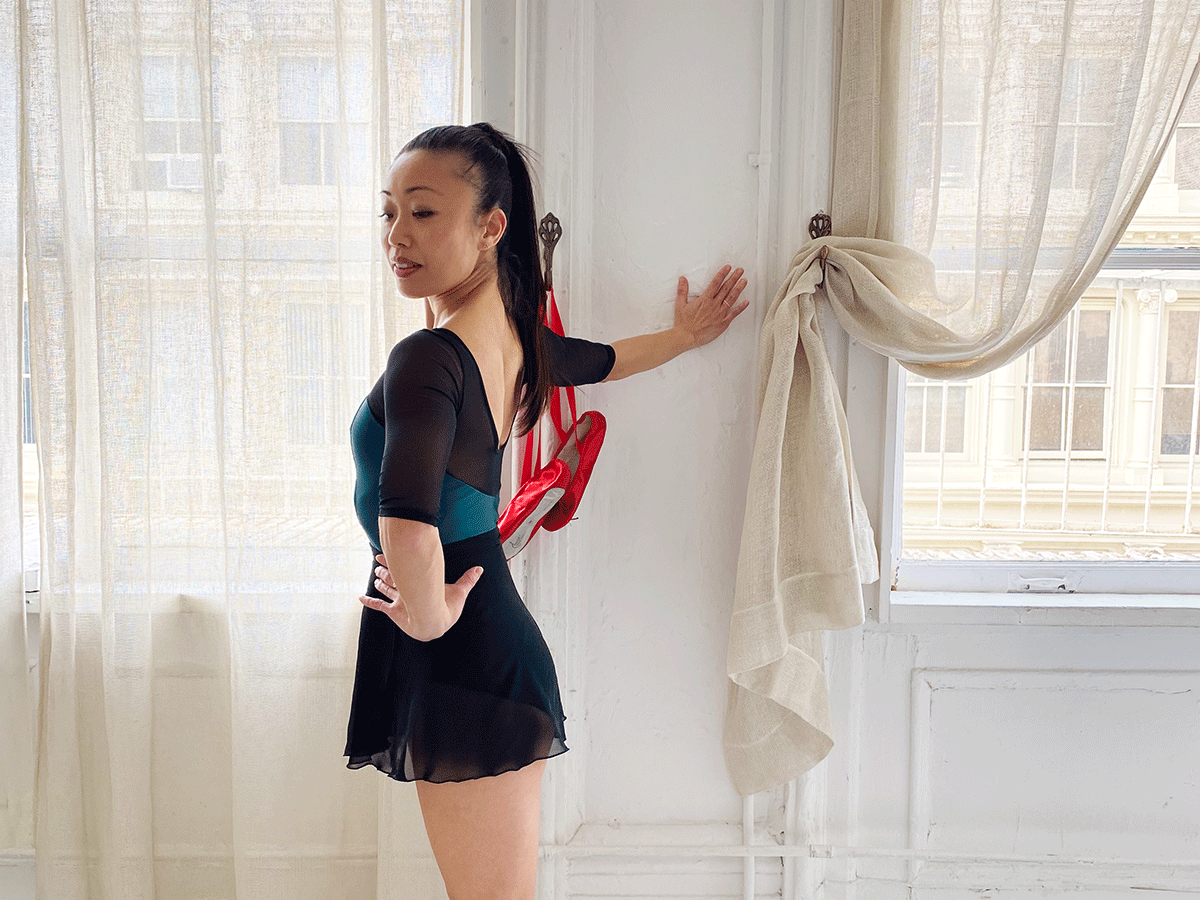
Move 9: Shoulder Stretch for Posture
Arm movement initiates from your shoulder blade (scapular). To tend to your posture, you need a stretch that targets the arms, starting at the middle of the back.
Stand beside a wall, about a foot or two away. The distance between you and the wall depends on your arm length and flexibility. Really tight? Start farther away. With hips and shoulders square and aligned, place the hand of the arm closest to the wall onto the highest point of the wall that you can reach. While counting to eight, slowly walk your fingers down to shoulder-height, creating a semi-circle shape, without moving your body. You’ll feel a stretch in your back and arms. Counting to eight again, slowly walk the fingers back up and repeat. Then repeat on the other side.
Total time: 1 minute, 4 seconds
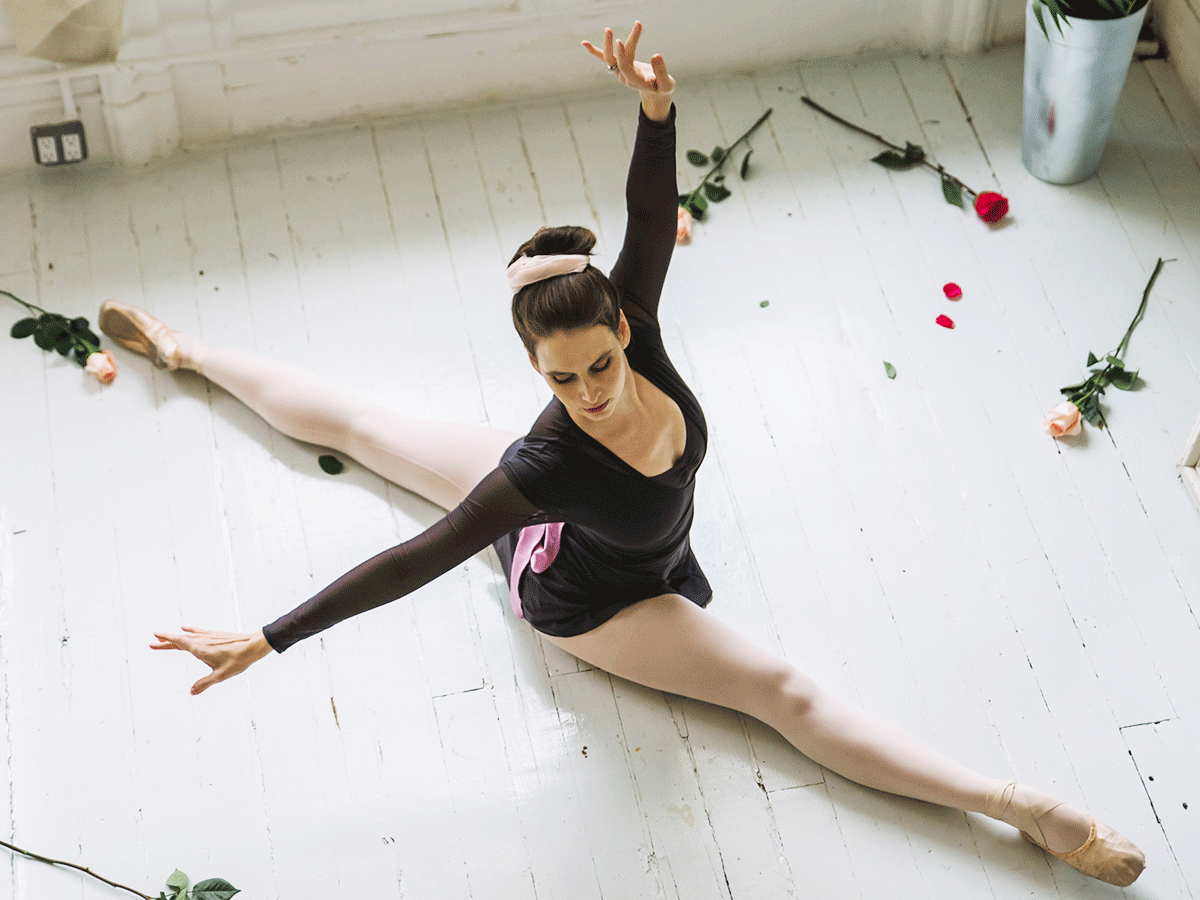
Looking for more?
Ballet Beautiful offers a custom workout subscription, which includes access to over 300 videos that can be mixed and matched for a full-body workout or a more targeted one. “The workouts focus on building strength through the core, the butt, the sides to building tone and elegance,” says Bowers. Best Health readers can use code BBHEALTH to get their first month of the Ballet Beautiful Custom Workout Subscription for $16.99 USD. The subscription will auto-renew at full price ($39.99 USD) after the first month ends, but users can cancel at any time.
Next, read BH editors’ reviews of the best workouts to stream (including Ballet Beautiful!).
